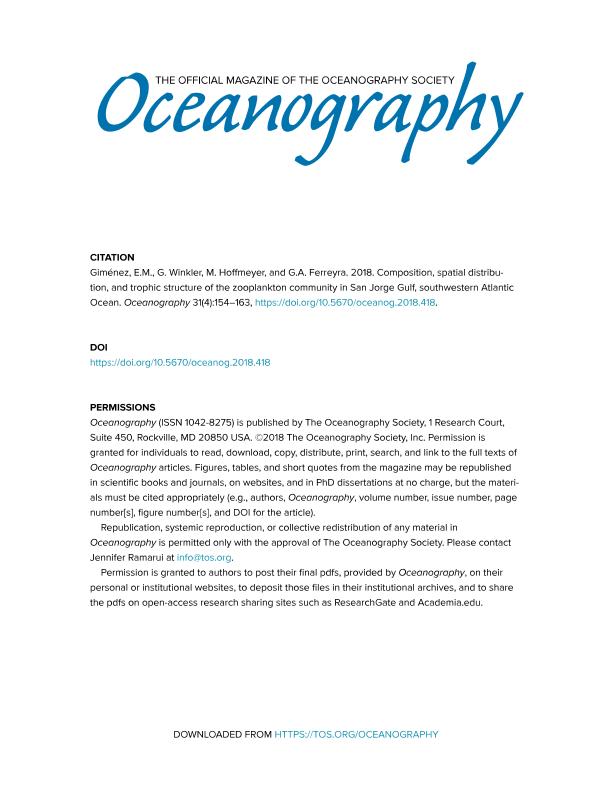Artículo
Composition, Spatial Distribution, and Trophic Structure of the Zooplankton Community in San Jorge Gulf, Southwestern Atlantic Ocean
Fecha de publicación:
12/2018
Editorial:
Oceanography Society
Revista:
Oceanography
ISSN:
1042-8275
Idioma:
Inglés
Tipo de recurso:
Artículo publicado
Clasificación temática:
Resumen
The goal of this study was to understand the zooplankton community composition and food web structure in San Jorge Gulf (45°–47°S, 65°30'W), a highly productive marine ecosystem in southern Argentina. A spatial grid of 14 stations was sampled in 2014. The sampled zooplankton community was composed of 30 taxa, with copepods accounting for 83% of the total abundance. Community composition was strongly related to surface temperature and water column stratification. Two distinct zooplankton assemblages were present. The zones designated North and Center were dominated by Ctenocalanus vanus; copepodite stages of C. vanus, Clausocalanus brevipes, and Paracalanus parvus; appendicularians; and Oithona helgolandica. The South zone was dominated by P. parvus, copepodites, Acartia tonsa, and Drepanopus forcipatus. The plankton food webs were increasingly enriched in carbon and nitrogen stable isotopes from the North to the South. Depleted δ 13 C signatures in the North may be explained by terrigenous inputs derived from strong westerly winds. The zooplankton taxa displayed a wide feeding range in the North, whereas the narrow trophic space of the South food web suggested similar feeding strategies among the taxa. Appendicularians were positioned at the base of the food webs, copepods were in the middle, and chaetognaths occupied high trophic positions.
Palabras clave:
Copepods
,
Assemblages
,
Stable isotope analyses
,
Pelagic food web
Archivos asociados
Licencia
Identificadores
Colecciones
Articulos(CADIC)
Articulos de CENTRO AUSTRAL DE INVESTIGACIONES CIENTIFICAS
Articulos de CENTRO AUSTRAL DE INVESTIGACIONES CIENTIFICAS
Articulos(IADO)
Articulos de INST.ARG.DE OCEANOGRAFIA (I)
Articulos de INST.ARG.DE OCEANOGRAFIA (I)
Citación
Giménez, Eloísa Mariana; Winkler, Glescher; Hoffmeyer, Monica Susana; Ferreyra, Gustavo Adolfo; Composition, Spatial Distribution, and Trophic Structure of the Zooplankton Community in San Jorge Gulf, Southwestern Atlantic Ocean; Oceanography Society; Oceanography; 31; 4; 12-2018; 154-163
Compartir
Altmétricas




